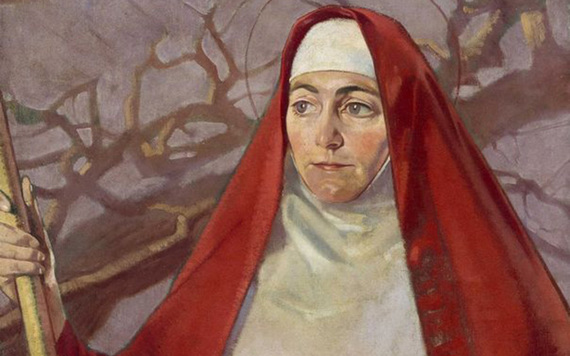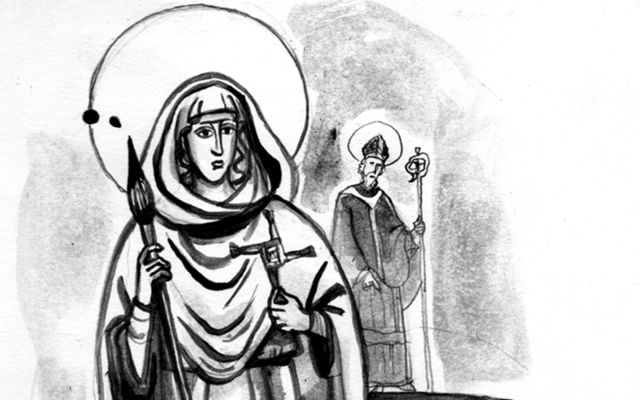Don't let gender discrimination stop you from giving Saint Brigid of Kildare the warm love, respect, and credit she deserves.
An artist with a golden touch is again tinting the Emerald Isle to its most beautiful these days. The scenery almost strikes the sight from my eyes. There is magic here.
All the trees that had been uniformly green through the summer are now radiant with about every color of the rainbow. There are whispering yellows and maroons and scarlets and coppers. And all the subtle tinctures in between.
To garnish all of that theatric show under the skies, the gentle end of the summer season has heavily laden all the shrubs with berries and fruits. You have never seen so many scarlet berries, ever, on the holly bushes or so many browning hazelnuts on their trees.
The wise old country folk I talk to tell me this is usually a sign we can expect a harsh winter, but sure that is far away yet and in the meantime, there is a visual spectacular to be relished from morning to evening.
Read more: Everything you need to know about St. Brigid ahead of St. Brigid's Day 2019
St. Brigid, Ireland's other patron saint, left in the shadow of a man
Strangely, though, the grandeur of my Dergside surroundings and a lovely icon on our mantelpiece sends me down a train of thought on the subject of gender discrimination and how that is as old as time. The icon I'm looking at is our St. Brigid's rushwork cross, still a standard and prized possession in most homes, its four exquisitely crafted arms radiating out like prayers from the delicately interwoven central square. It is a thing or organic beauty indeed.
Read more: Why Irish women should follow St. Brigid, not just St. Patrick
It is the recognition of that, somehow, which brings me to that thorny perennial subject of gender discrimination because, in a nutshell, our other great patron saint St. Brigid of Kildare has never, ever, been given the warm love and respect and credit she deserves by we Irish. She has always been in the dark enough shadow of St. Patrick, the ascetic one, and she deserves so much more than that.

St. Brigid of Kildare.
St. Patrick, yes, is credited with converting us to Christianity in the dark ages. His legacy is powerfully international and growing every year. All know that his feast day on March 17, when the world shakes to the marching feet and the skirling of thousands of pipe bands behind his banners.
But many of us, to our eternal shame, do not know at all that St. Brigid's equally important feast day is the first day of February. Cruelly it passes almost unnoticed. Gender discrimination?
I would argue with some force that there was and is a killjoy facet to St. Patrick's work amongst us. In defeating the druids he killed a lot of our integral Celtic craic and joy of life and living, maybe even sometimes to excess.
It is apt that his most enduring icon in Ireland is the dreadfully punishing three-day barefoot pilgrimage on St. Patrick's Purgatory island in Lough Derg above in Donegal. The island groans beneath the weight of thousands of great cold churches named after him, frequently empty enough in this era, their sharp spires ripping open the clouds that drench us with winter rain.
The enduring legacy of St. Brigid, the celestial artist
St. Brigid, on the other hand, both in her mortal existence after her birth in Kildare, and now from heaven above, is the celestial artist who is creating the wondrous naturalist beauty around Ireland today. And I am not pulling that argument out of my hat either.
History clearly records according to all sources that Brigid was not just an artist in her time but also actually established a leading School of Art in her heyday in her native Kildare. Check that out for yourselves if you don't believe me.
She also led the creative project which led to the establishment of the fabled Book of Kildare which, had it survived the Cromwellian atrocities here, would have been as famous and celebrated today as the Book of Kells.
I believe this great, great under-recognized patron saint of ours was born the daughter of a slave in harsher times than these. From that, she soared upwards, both in her mortal and immortal existences.
And, in conclusion, surely there has been gender discrimination in relation to the honor and respect we show to the mighty artist who is painting our island golden these autumn days.
Read more: How is St. Brigid connected with the great Celtic goddess?
* Originally published in October 2017.




Comments